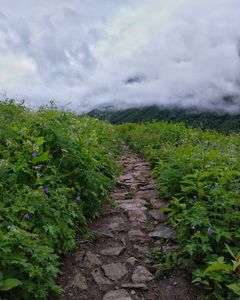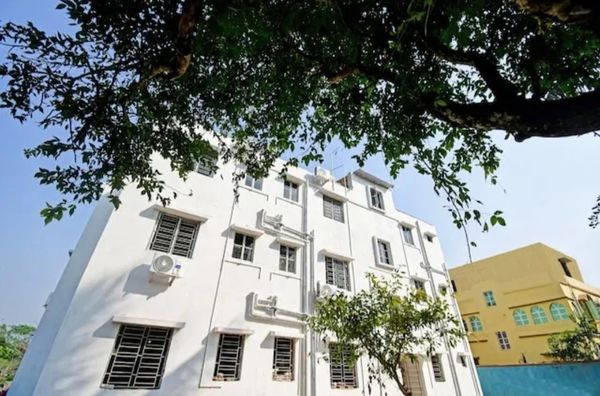Nanda Devi Biosphere Reserve – A Hidden Himalayan Wilderness
 Deepanshu Negi
06 Aug, 2025
10 mins read
35
Deepanshu Negi
06 Aug, 2025
10 mins read
35

Nestled in the heart of Uttarakhand, the Nanda Devi Biosphere Reserve is one of India’s most stunning and ecologically rich protected areas. Centered around the towering Nanda Devi peak (7,816 meters), the reserve spreads across the Chamoli, Pithoragarh, and Bageshwar districts, forming part of the greater Western Himalayan landscape.
Designated a UNESCO World Biosphere Reserve in 1988, it includes the Nanda Devi National Park and Valley of Flowers National Park, both globally recognized for their biodiversity and natural beauty. With deep gorges, snow-covered peaks, alpine meadows, and glacial basins, the reserve offers a blend of adventure, conservation, and spirituality that few places can match.
A Glimpse into the History of the Reserve
The region surrounding Nanda Devi has long been considered sacred by locals, with the mountain itself worshipped as a goddess. In 1934, British mountaineers Eric Shipton and H.W. Tilman explored the inner sanctuary of Nanda Devi for the first time, opening up a new era of Himalayan exploration.
To protect the fragile environment, the Indian government closed the core area of the Nanda Devi Sanctuary to trekkers in 1982. Since then, conservation efforts have increased, culminating in its recognition as a UNESCO World Heritage Site. Today, limited eco-tourism is allowed in buffer zones, with a strong focus on sustainability and preservation of local culture.
How to Reach Nanda Devi Biosphere Reserve
By Air:
The nearest airport is Jolly Grant Airport in Dehradun (approx. 295 km). From there, taxis or buses are available to Joshimath, the gateway to the biosphere reserve.
By Road:
Joshimath is well connected by road to Rishikesh, Haridwar, and Dehradun. From Joshimath, travelers proceed to villages like Lata or Badrinath, which serve as base points for treks and visits.
By Rail:
The nearest major railway stations are Haridwar and Rishikesh, both of which are connected to major cities across India.
Best Time to Visit Nanda Devi Biosphere Reserve
- Summer (May to June): Pleasant weather, clear views, and full access to trekking routes.
- Monsoon (July to September): Valley of Flowers is in full bloom, though trails may be slippery.
- Autumn (October): Great visibility and fewer crowds, just before winter closes the high-altitude zones.
- Winter (November to April): Harsh and snowy ideal only for lower altitude areas and seasoned explorers.
Top Places to Visit in and Around the Reserve
1. Nanda Devi National Park
A high-altitude sanctuary known for its unmatched biodiversity, glacial terrain, and remoteness. While entry to the inner core zone is restricted, the buffer areas around the park provide breathtaking views of snow-capped peaks, a glimpse of rare Himalayan flora and fauna, and a sense of untouched wilderness.
2. Valley of Flowers National Park
This UNESCO World Heritage Site is a paradise of alpine blooms, where over 500 species of wildflowers turn the valley into a natural canvas during the monsoon. Set against a backdrop of towering peaks, it’s a must-visit for botanists, photographers, and anyone seeking nature’s vibrant side.
3. Lata Village and Lata Kharak Trek
Lata is a traditional Bhotiya village that played a key role in the Chipko Movement and ongoing conservation efforts. From here, treks lead through dense forests and alpine ridges to Lata Kharak, a viewpoint offering commanding vistas of the Nanda Devi massif and insight into local ecology.
4. Joshimath
This gateway town to the biosphere reserve offers a mix of spirituality, trekking access, and mountain hospitality. Apart from being a stopover for Badrinath and Auli, Joshimath hosts ancient temples and serves as a resupply and acclimatization point for treks deeper into the Himalayas.
5. Auli
Auli is a scenic hill station and ski resort known for its panoramic views of Nanda Devi, Mana Parvat, and other snowy giants. During summer, its grassy meadows become perfect for nature walks, short hikes, and relaxation amid clean alpine air and peaceful surroundings.
Trekking Routes Around Nanda Devi Biosphere Reserve
1. Lata Kharak to Dharansi Pass
This offbeat and challenging trail offers a raw Himalayan experience with steep forest climbs, narrow ridges, and dramatic views into the forbidden Nanda Devi Sanctuary. The trek demands good physical fitness and special permits, making it ideal for seasoned adventurers seeking solitude and scenic grandeur.
2. Valley of Flowers and Hemkund Sahib
A classic Himalayan route blending natural beauty with spiritual depth. Trekkers pass through flower-filled meadows, cross wooden bridges, and ascend to Hemkund Sahib a revered Sikh shrine set beside a pristine glacial lake at 4,329 meters. The best time is mid-July to late August.
3. Kuari Pass Trek
Ideal for beginners and families, this trail winds through oak forests, alpine pastures, and charming villages. Kuari Pass offers panoramic views of several peaks including Nanda Devi, Dronagiri, and Kamet. It’s also known as the “Curzon Trail,†named after a British viceroy who popularized it.
4. Roopkund Trek (via Ali Bugyal)
Among Uttarakhand’s most iconic treks, this trail takes you through the lush alpine meadows of Ali and Bedni Bugyal before ascending to the mysterious Roopkund Lake, famous for human skeletons lying beneath its surface. It’s a blend of natural beauty, adventure, and archaeological intrigue.
Quick Tips for Visiting Nanda Devi Biosphere Reserve
- Entry to core zones is restricted—book eco-treks through certified agencies.
- Respect local customs and wildlife—no littering or loud noises.
- Carry eco-friendly supplies like reusable bottles and biodegradable soaps.
- Hire local guides—they offer rich insights and ensure safety.
- Acclimatize properly if trekking to high altitudes above 3,000 meters.
Final Thoughts
The Nanda Devi Biosphere Reserve is not just a destination it’s a living, breathing ecosystem where nature thrives alongside culture and spirituality. From the serene beauty of the Valley of Flowers to the towering presence of Nanda Devi herself, the region leaves a deep impression on every traveler.
Whether you're a trekker, a nature lover, or someone seeking peace in the high Himalayas, this biosphere reserve offers experiences that go far beyond sightseeing. It’s a place to reflect, to respect, and to reconnect with the mountains, and with yourself.
Written By:
Deepanshu Negi



Hotels at your convenience
Now choose your stay according to your preference. From finding a place for your dream destination or a mere weekend getaway to business accommodations or brief stay, we have got you covered. Explore hotels as per your mood.


